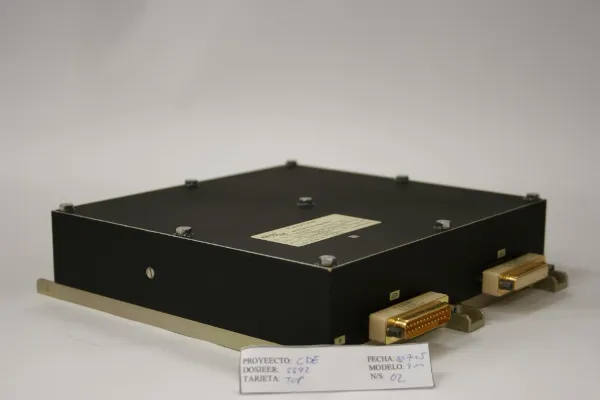The University of Granada (UGR) was financially and scientifically involved in the project:
Financially, UGR funded the construction of a Current Pre-Regulator for the High Frequency Instrument (HFI) of the Planck satellite.
The scientific interests of UGR focus on the influence of the magnetic fields on the angular spectrum of anisotropies in the CMB.
E. Battaner has been co-investigator of the HFI, “Planck Scientist”, principal investigator of the project Constraints on primordial magnetic fields within the WG4 and Core Team Member.
Prof. Eduardo Battaner Lopez was Project Co-Investigator (Co-I) and “Planck Scientist” . Dr. Ute Lisenfeld was Associate Investigator. Prof. Estrella Florido Navio was Project Researcher. Marco Azzaro was the Project Manager.
The Univeristy of Granada is financially involved in the Planck mission, and more precisely in the High Frequency Instrument (HFI) of the satellite. The heart of this instrument is an array of sensors which needs to be kept at an extremely low temperature (0.1 K), to be able to detect the faint microwave background signal. This extreme temperature is reached with a four-stage cooler, first cooling at 18K, then to 4K, 1.6K and finally at 0.1K. The instantaneous peak power demand of cooler subsystems ranges within 3 to 5 times their average consumption (i.e. up to 500W peak). This represents a potential integration risk for the power subsystem and for the quality of the power delivered, as the cooler subsystem is a significant contributor within the Spacecraft power budget. The solution is to have a Pre-Regulator to stabilize the input current to the cooler, with negligible effects on mass and electrical consumption of the instrument.

This is the device that the University of Granada is financing and managing, through the spanish engineering firm Crisa.
Primordial magnetic fields may have important effects on the Cosmic Microwave Background (CMB). Apart from their influence on secondary anisotropies, the Last Scattering Surface (LSS) could preserve the imprints of magnetic fields, modifying the anisotropies spectrum as well as the polarization pattern. Therefore, the determination of cosmológical parameters from these spectra should be corrected if magnetic fields actually play a role. The influence of magnetic fields on the formation of the large scale of the Universe has been studied previously, showing that primordial comoving field strengths in the range 10(-9)-10(-8) G could have a non negligible effect. These strengths should affect, in turn, the CMB anisotropy spectrum, contributing to non-Gaussianity of the temperature distribution, thus causing the formation of anisotropic filaments, which would intersect the LSS and produce other measurable effects. Magnetic fields act on free electrons wihch are coupled to photons through Thomson scattering and to protons through Coulomb interactions. Magnetic fields, CDM, dark energy, photons, electrons, protons and neutrons are the components of our model, which have different amounts of coupling through the different epochs of the Universe. The evolution of a filament created by a primordial magnetic flux tube will be reproduced through the radiation dominated era, the epoch of DM and radiation energy densities equality, until reaching photon decoupling at Recombination. The statistical evolution of these initial perturbations will in turn be followed in Fourier Space to determine the final anisotropy spectrum. The formation of primordial magnetic structures is another of our objectives. The anisotropy spectrum to be expected from non random structures, such as the so called “fractal egg-carton” universe, is another topic to be undertaken, for a comparison with universes with random primordial spectra. There is an interesting possibility of finding Faraday Rotation in the CMB radiation, through the polarization that Planck will measure with unprecedented sensitivity. Preparatory work for interpreting Planck measurements is in progress.
The existence of primordial magnetic fields, the quantitative determination of these or, at least, the setting of an upper limit of their strengths, are all achievements that could be provided by the Planck Mission.
The Planck project was selected in 1996 as third medium sized mission in the ESA Horizon 2000 programme. The aim was to map the whole sky in the range 30-900 GHz with unprecedented resolution and sensitivity, and, remarkably, to perform a high precision polarimetry survey of the whole sky. The Planck satellite was successfully launched on 14 May 2009 and it was turned off on 23 October 2013.
There have been three spanish institutions involved in the Planck collaboration: IAC (Rafael Rebolo), IFCA (Enrique Martínez) and UGR (Eduardo Battaner).
These data will reveal details of the distribution and topology of the Cosmic Microwave Background (CMB), which reflect fundamental properties of the Universe in its primordial status. The resolution of Planck data will be better than 10 arcminutes, with a sensitivity of a few microK.
The data will be collected by a Low Frequency Instrument (LFI) and a High Frequency Instrument (HFI), whose ranges are about 30-70 GHz and 100-860 GHz respectively.
All the theories of structure formation in the Universe predict some anisotropy of the CMB, which depends on the geometry of the Universe and on the basic elements of matter. In this context, the Planck data will be extremely useful to investigate:
Other related links are: